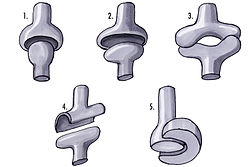|
Condyloid joint
A condyloid joint (also called condylar, ellipsoidal, or bicondylar[1]) is an ovoid articular surface, or condyle that is received into an elliptical cavity. This permits movement in two planes, allowing flexion, extension, adduction, abduction, and circumduction. ExamplesExamples include:[2] These are also called ellipsoid joints. The oval-shaped condyle of one bone fits into the elliptical cavity of the other bone. These joints allow biaxial movements[3] — i.e., forward and backward, or from side to side, but not rotation. Radiocarpal joint and metacarpophalangeal joint are examples of condyloid joints. An example of an Ellipsoid joint is the wrist; it functions similarly to the ball and socket joint except is unable to rotate 360 degrees; it prohibits axial rotation. References
Wikimedia Commons has media related to Condyloid joints. |
||||||||||||||||||||

